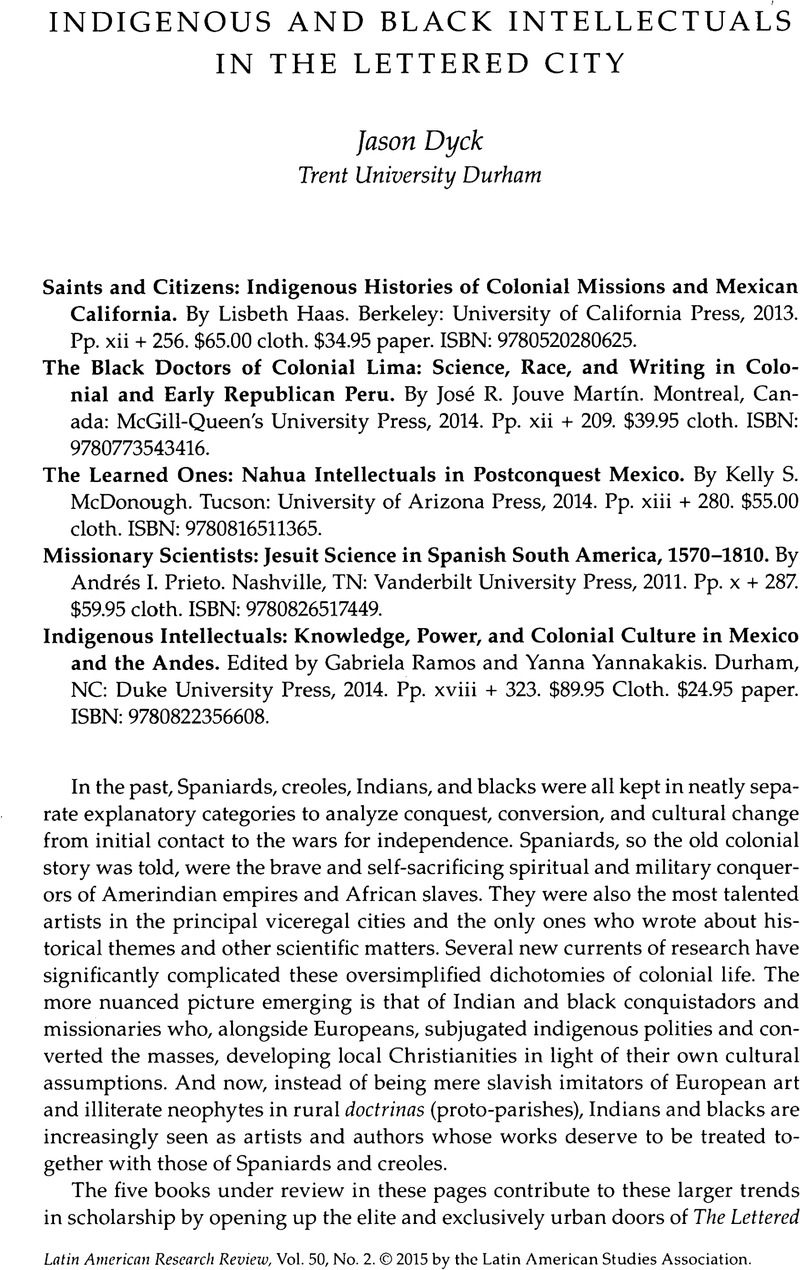Article contents
Indigenous and Black Intellectuals in the Lettered City
Review products
Published online by Cambridge University Press: 05 September 2022
Abstract

- Type
- Review Essays
- Information
- Copyright
- Copyright © 2015 by the Latin American Studies Association
References
1. Ángel Rama, La ciudad letrada (Hanover: Ediciones del Norte, 1984).
2. José de Acosta, Natural and Moral History of the Indies, trans. Frances López-Morillas, ed. Jane E. Mangan (Durham, NC: Duke University Press, 2002).
3. Antonello Gerbi, The Dispute of the Nezv World: The History of a Polemic, 1750-1900, trans. Jeremy Moyle (1955; Pittsburgh: University of Pittsburgh Press, 1973).
4. Mary Louise Pratt, Imperial Eyes: Travel Writing and Transculturation, 2nd ed. (1992; London: Routledge, 2008).
5. James Lockhart, The Nahuas after the Conquest: A Social and Cultural History of the Indians of Central Mexico, Sixteenth through Eighteenth Centuries (Stanford, CA: Stanford University Press, 1992).
6. Susan Schroeder, ed., The Conquest All Over Again: Nahuas and Zapotecs Thinking, Writing, and Painting Spanish Colonialism (Eastbourne: Sussex Academic Press, 2010).
7. Rigoberta Menchú Turn, I, Rigoberta Menchú: An Indian Woman in Guatemala, ed. Elisabeth Burgos-Debray, trans. Ann Wright (1983; London: Verso, 2009) and Rosa Isolde Reuque Paillalef, When a Flower in Reborn: The Life and Times of a Mapuche Feminist, ed. and trans. Florencia E. Mallon (Durham, NC: Duke University Press, 2002).
8. Erick Langer and Robert H. Jackson, eds., The New Latin American Mission History (Lincoln: University of Nebraska Press, 1995).
9. For a pioneering example, see Nancy M. Farriss, Maya Society under Colonial Rule: The Collective Enterprise of Survival (Princeton, NJ: Princeton University Press, 1984).
10. Still relevant to this topic is Inga Clendinnen, “Ways to the Sacred: Reconstructing ‘Religion’ in Sixteenth Century Mexico,” History and Anthropology 5, no. 1 (1990): 105-141.
11. For two earlier examples, see Gauvin Alexander Bailey, Art on the Jesuit Missions in Asia and Latin America, 1542-1773 (Toronto: University of Toronto Press, 1999), and Serge Gruzinski, Images at War: Mexico from Columbus to Blade Runner (1492-2019), trans. Heather MacLean (1990: Durham, NC: Duke University Press, 2001).
12. For two examples, see Laura E. Matthew and Michel R. Oudijk, eds., Indian Conquistadors: Indigenous Allies in the Conquest of Mesoamerica (Norman: Oklahoma Press, 2007), and Laura E. Matthew, Memories of Conquest: Becoming Mexicano in Colonial Guatemala (Chapel Hill: University of North Carolina Press, 2012).
13. See John Charles Chasteen, National Rhythms, African Roots: The Deep History of Latin American Popular Dance (Albuquerque: University of New Mexico Press, 2004); George Reid Andrews, Blackness in the White Nation: A History of Afro-Uruguay (Chapel Hill: University of North Carolina Press, 2010); and George Reid Andrews, Afro-Latin America, 1800-2000 (Oxford: Oxford University Press, 2004).
14. Jorge Cañizares-Esguerra, Nature, Empire, and Nation: Explorations of the History of Science in the Iberian World (Stanford, CA: Stanford University Press, 2006).
15. See David A. Brading, The First America: The Spanish Monarchy, Creole Patriots, and the Liberal State, 1492-1867 (Cambridge: Cambridge University Press, 1991). For a more recent study, see Ralph Bauer and José Antonio Mazzotti, eds., Creole Subjects in the Colonial Americas: Empires, Texts, Identities (Chapel Hill: University of North Carolina Press, 2009).
16. For two recent examples, see Peter Blanchard, Under the Flags of Freedom: Slave Soldiers and the Wars of Independence in Spanish South America (Pittsburgh: University of Pittsburgh Press, 2008) and James E. Sanders, Contentious Republicans: Popular Politics, Race, and Class in Nineteenth-Century Colombia (Durham, NC: Duke University Press, 2004).
17. For medical pluralism, see David Sowell, The Tale of Healer Miguel Perdomo Neira: Medicine, Ideologies, and Power in the Nineteenth-Century Andes (Wilmington, DE: Scholarly Resources, 2001).
- 4
- Cited by




